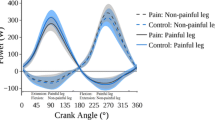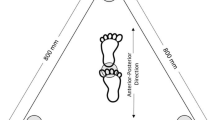Abstract
Purpose
Although it appears obvious that we change movement behaviors to unload the painful region, non-systematic motor adaptations observed in simple experimental tasks with pain question this theory. We investigated the effect of unilateral pain on performance of a bilateral plantarflexion task. This experimental task clearly allowed for stress on painful tissue to be reduced by modification of load sharing between legs.
Methods
Fourteen participants performed a bilateral plantarflexion at 10, 30, 50 and 70 % of their MVC during 5 conditions (Baseline, Saline-1, Washout-1, Saline-2, Washout-2). For Saline-1 and -2, either isotonic saline (Iso) or hypertonic saline (Pain) was injected into the left soleus.
Results
The force produced by the painful leg was less during Pain than Baseline (range −52.6 % at 10 % of MVC to −20.1 % at 70 % of MVC; P < 0.003). This was compensated by more force produced by the non-painful leg (range 18.4 % at 70 % of MVC to 70.2 % at 10 % of MVC; P < 0.001). The reduction in plantarflexion force was not accompanied by a significant decrease in soleus electromyographic activity at 10 and 30 % of MVC. Further, no significant linear relationship was found between changes in soleus electromyographic activity and change in plantarflexion force for the painful leg (with the exception of a weak relationship at 10 % of MVC, i.e., R 2 = 0.31).
Conclusion
These results show that when the nervous system is presented with an obvious solution to decrease stress on irritated tissue, this option is selected. However, this was not strongly related to a decrease in soleus (painful muscle) activity level.





Similar content being viewed by others
Abbreviations
- EMG:
-
Electromyography
- GM:
-
Gastrocnemius medialis
- GL:
-
Gastrocnemius lateralis
- Iso:
-
Isotonic
- MVC:
-
Maximal voluntary contraction
- SOL:
-
Soleus
- TA:
-
Tibialis anterior
- WO:
-
Washout
References
Bank PJ, Peper CE, Marinus J, Beek PJ, van Hilten JJ (2013) Motor consequences of experimentally induced limb pain: a systematic review. Eur J Pain 17(2):145–157. doi:10.1002/j.1532-2149.2012.00186.x
Bouillard K, Nordez A, Hug F (2011) Estimation of individual muscle force using elastography. PLoS ONE 6(12):e29261. doi:10.1371/journal.pone.0029261
Bouillard K, Hug F, Guevel A, Nordez A (2012) Shear elastic modulus can be used to estimate an index of individual muscle force during a submaximal isometric fatiguing contraction. J Appl Physiol 113(9):1353–1361. doi:10.1152/japplphysiol.00858.2012
Ciubotariu A, Arendt-Nielsen L, Graven-Nielsen T (2004) The influence of muscle pain and fatigue on the activity of synergistic muscles of the leg. Eur J Appl Physiol 91(5–6):604–614. doi:10.1007/s00421-003-1026-9
Cohen JH (1988) Statistical power analysis for the behavioral sciences. Lawrence Earlbaum, New Jersey
Cresswell AG, Loscher WN, Thorstensson A (1995) Influence of gastrocnemius muscle length on triceps surae torque development and electromyographic activity in man. Exp Brain Res 105(2):283–290
Crossley KM, Dorn TW, Ozturk H, van den Noort J, Schache AG, Pandy MG (2012) Altered hip muscle forces during gait in people with patellofemoral osteoarthritis. Osteoarthr Cartil 20(11):1243–1249. doi:10.1016/j.joca.2012.07.011
Fadiga L, Craighero L, Dri G, Facchin P, Destro MF, Porro CA (2004) Corticospinal excitability during painful self-stimulation in humans: a transcranial magnetic stimulation study. Neurosci Lett 361(1–3):250–253. doi:10.1016/j.neulet.2003.12.016
Farina D, Arendt-Nielsen L, Merletti R, Graven-Nielsen T (2004a) Effect of experimental muscle pain on motor unit firing rate and conduction velocity. J Neurophysiol 91(3):1250–1259. doi:10.1152/jn.00620.2003
Farina D, Merletti R, Enoka RM (2004b) The extraction of neural strategies from the surface EMG. J Appl Physiol 96(4):1486–1495. doi:10.1152/japplphysiol.01070.2003
Finni T, Hodgson JA, Lai AM, Edgerton VR, Sinha S (2003) Nonuniform strain of human soleus aponeurosis-tendon complex during submaximal voluntary contractions in vivo. J Appl Physiol 95(2):829–837. doi:10.1152/japplphysiol.00775.2002
Graven-Nielsen T, Svensson P, Arendt-Nielsen L (1997) Effects of experimental muscle pain on muscle activity and co-ordination during static and dynamic motor function. Electroencephalogr Clin Neurophysiol 105(2):156–164
Graven-Nielsen T, Jansson Y, Segerdahl M, Kristensen JD, Mense S, Arendt-Nielsen L, Sollevi A (2003) Experimental pain by ischaemic contractions compared with pain by intramuscular infusions of adenosine and hypertonic saline. Eur J Pain 7(1):93–102
Hirata RP, Arendt-Nielsen L, Graven-Nielsen T (2010) Experimental calf muscle pain attenuates the postural stability during quiet stance and perturbation. Clin Biomech 25(9):931–937. doi:10.1016/j.clinbiomech.2010.06.001
Hirata RP, Ervilha UF, Arendt-Nielsen L, Graven-Nielsen T (2011) Experimental muscle pain challenges the postural stability during quiet stance and unexpected posture perturbation. J Pain 12(8):911–919. doi:10.1016/j.jpain.2011.02.356
Hodges PW, Tucker K (2011) Moving differently in pain: a new theory to explain the adaptation to pain. Pain 152(3 Suppl):S90–S98. doi:10.1016/j.pain.2010.10.020
Hodges PW, Ervilha UF, Graven-Nielsen T (2008) Changes in motor unit firing rate in synergist muscles cannot explain the maintenance of force during constant force painful contractions. J Pain 9(12):1169–1174. doi:10.1016/j.jpain.2008.06.012
Hug F (2011) Can muscle coordination be precisely studied by surface electromyography? J Electromyogr Kinesiol 21(1):1–12. doi:10.1016/j.jelekin.2010.08.009
Hug F, Hodges PW, Tucker KJ (2013) Effect of pain location on spatial reorganisation of muscle activity. J Electromyogr Kinesiol 23(6):1413–1420. doi:10.1016/j.jelekin.2013.08.014
Madeleine P, Arendt-Nielsen L (2005) Experimental muscle pain increases mechanomyographic signal activity during sub-maximal isometric contractions. J Electromyogr Kinesiol 15(1):27–36. doi:10.1016/j.jelekin.2004.06.006
Martin DC, Medri MK, Chow RS, Oxorn V, Leekam RN, Agur AM, McKee NH (2001) Comparing human skeletal muscle architectural parameters of cadavers with in vivo ultrasonographic measurements. J Anat 199(Pt 4):429–434
Meyer AJ, D’Lima DD, Besier TF, Lloyd DG, Colwell CW Jr, Fregly BJ (2013) Are external knee load and EMG measures accurate indicators of internal knee contact forces during gait? J Orthop Res 31(6):921–929. doi:10.1002/jor.22304
Mundermann A, Dyrby CO, Andriacchi TP (2005) Secondary gait changes in patients with medial compartment knee osteoarthritis: increased load at the ankle, knee, and hip during walking. Arthritis Rheum 52(9):2835–2844. doi:10.1002/art.21262
Staahl C, Drewes AM (2004) Experimental human pain models: a review of standardised methods for preclinical testing of analgesics. Basic Clin Pharmacol Toxicol 95(3):97–111. doi:10.1111/j.1742-7843.2004.950301.x
Tian M, Herbert RD, Hoang P, Gandevia SC, Bilston LE (2012) Myofascial force transmission between the human soleus and gastrocnemius muscles during passive knee motion. J Appl Physiol 113(4):517–523. doi:10.1152/japplphysiol.00111.2012
Tsao H, Tucker KJ, Coppieters MW, Hodges PW (2010) Experimentally induced low back pain from hypertonic saline injections into lumbar interspinous ligament and erector spinae muscle. Pain 150(1):167–172. doi:10.1016/j.pain.2010.04.023
Tucker KJ, Hodges PW (2010) Changes in motor unit recruitment strategy during pain alters force direction. Eur J Pain 14(9):932–938. doi:10.1016/j.ejpain.2010.03.006
Tucker K, Butler J, Graven-Nielsen T, Riek S, Hodges P (2009) Motor unit recruitment strategies are altered during deep-tissue pain. J Neurosci 29(35):10820–10826. doi:10.1523/JNEUROSCI.5211-08.2009
van Zandwijk JP, Bobbert MF, Harlaar J, Hof AL (1998) From twitch to tetanus for human muscle: experimental data and model predictions for m. triceps surae. Biol Cybern 79(2):121–130
Acknowledgments
The authors thank Jean HUG for drawing Fig. 1a. NHMRC provides research fellowships for PH: ID401599 and KT: ID1009410. Project support was provided by an NHMRC Program grant (PH: ID631717).
Conflict of interest
No conflict of interest.
Author information
Authors and Affiliations
Corresponding author
Additional information
Communicated by Nicolas Place.
Rights and permissions
About this article
Cite this article
Hug, F., Hodges, P.W., Salomoni, S.E. et al. Insight into motor adaptation to pain from between-leg compensation. Eur J Appl Physiol 114, 1057–1065 (2014). https://doi.org/10.1007/s00421-014-2840-y
Received:
Accepted:
Published:
Issue Date:
DOI: https://doi.org/10.1007/s00421-014-2840-y




